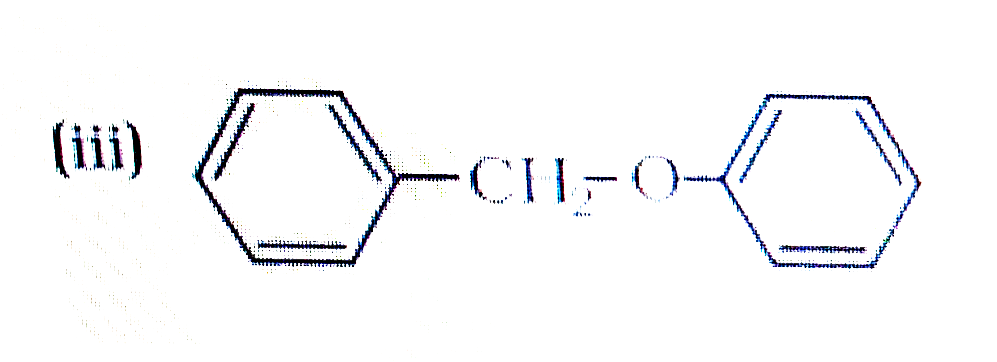CH3−CH=CH−CH2−CH3HI−−→Amajor
Compound A is
CH3−CH2−C∣∣H−CH2−CH3
CH3−C∣∣H−CH2−CH2−CH3
CH3−CH2∣C∣∣−CH2−CH3
CH3−CH3∣C∣CH3−CH2I
The correct Answer is:2
To solve the question regarding the reaction of 1-pentene (CH₃-CH=CH-CH₂-CH₃) with hydroiodic acid (HI) to form compound A, we will follow these steps:
Step 1: Identify the Structure of the Given Compound
The given compound is 1-pentene, which has the following structure:
CH₃|CH=CH|CH₂∣CH₃
Step 2: Apply Markovnikov's Rule
When HI adds to an alkene, it follows Markovnikov's rule, which states that the hydrogen atom (H) will attach to the carbon with the greater number of hydrogen atoms, while the iodine (I) will attach to the carbon with fewer hydrogen atoms.
Step 3: Determine Possible Carbocation Intermediates
1. The double bond is between the second and third carbon atoms. When H⁺ adds to the second carbon (C-2), it will create a carbocation on the third carbon (C-3).
2. Alternatively, if H⁺ adds to the third carbon (C-3), it will create a carbocation on the second carbon (C-2).
Step 4: Analyze the Stability of the Carbocations
1. Carbocation at C-3: This carbocation is a secondary carbocation, which is relatively stable due to the presence of two alkyl groups.
2. Carbocation at C-2: This carbocation is a primary carbocation, which is less stable compared to the secondary carbocation.
Step 5: Consider the Attack of Iodide Ion (I⁻)
The iodide ion (I⁻) will attack the more stable carbocation. Since the secondary carbocation at C-3 is more stable, the I⁻ will preferentially attack this position.
Step 6: Draw the Final Product
When I⁻ attacks the secondary carbocation formed at C-3, the final product (Compound A) will be:
CH₃|CH|CH₂∣I
This corresponds to 2-iodopentane (C₅H₁₃I).
Conclusion
The major product A formed from the reaction of 1-pentene with HI is 2-iodopentane.
---
The given compound is 1-pentene, which has the following structure:
When HI adds to an alkene, it follows Markovnikov's rule, which states that the hydrogen atom (H) will attach to the carbon with the greater number of hydrogen atoms, while the iodine (I) will attach to the carbon with fewer hydrogen atoms.
1. The double bond is between the second and third carbon atoms. When H⁺ adds to the second carbon (C-2), it will create a carbocation on the third carbon (C-3).
2. Alternatively, if H⁺ adds to the third carbon (C-3), it will create a carbocation on the second carbon (C-2).
1. Carbocation at C-3: This carbocation is a secondary carbocation, which is relatively stable due to the presence of two alkyl groups.
2. Carbocation at C-2: This carbocation is a primary carbocation, which is less stable compared to the secondary carbocation.
The iodide ion (I⁻) will attack the more stable carbocation. Since the secondary carbocation at C-3 is more stable, the I⁻ will preferentially attack this position.
When I⁻ attacks the secondary carbocation formed at C-3, the final product (Compound A) will be:
The major product A formed from the reaction of 1-pentene with HI is 2-iodopentane.
Topper's Solved these Questions
- HYDROCARBONSBOOK - AAKASH INSTITUTE ENGLISHCHAPTER - HYDROCARBONSEXERCISE - Assignment(Section - B) (Obejctive type question)
5 Videos
- HYDROCARBONSBOOK - AAKASH INSTITUTE ENGLISHCHAPTER - HYDROCARBONSEXERCISE - Assignment(Section - C) (Previous Years Questions)
60 Videos
- HYDROCARBONSBOOK - AAKASH INSTITUTE ENGLISHCHAPTER - HYDROCARBONSEXERCISE - Exercise
33 Videos
- HALOALKANES AND HALOARENES BOOK - AAKASH INSTITUTE ENGLISHCHAPTER - HALOALKANES AND HALOARENES EXERCISE - ASSIGNMENT SECTION -D
15 Videos
- HYDROGENBOOK - AAKASH INSTITUTE ENGLISHCHAPTER - HYDROGENEXERCISE - ASSIGNMENT (SECTION - D) (Assertion-Reason Type question)
15 Videos
Similar Questions
Knowledge Check
CH3−CH2−CH2−CH2−CH3∣C∣CH3−CH2−OHH+−−→ΔA(major) product (A) is :
ACH3−CH2−CH2−CH2−CH2−C∣CH3=CH−CH3B CCH3−CH2−CH2−CH2−C∣CH3=CH2DCH3−CH2−CH∣CH3−CH2−CH3∣C−CH2
CCH3−CH2−CH2−CH2−C∣CH3=CH2DCH3−CH2−CH∣CH3−CH2−CH3∣C−CH2For each of the following pairs ofE2 reaction, selectthe one thatoccurs withthe greaterrate constant
(1) CH3CH2CH2Cl+CH3−CH3∣C∣CH3−O−
(2) CH3CH2CH2I+CH3−CH3∣C∣CH3−O−
(3) H3C−C∣BrH−CH3+CH3O−
(4) H3C−C∣BrH−CH3+CH3S−
 A2,4,6B1,3,5C2,3,5D2,4,5
A2,4,6B1,3,5C2,3,5D2,4,5
Write the IUPAC names of the following:
CH3−CH2−CH2−CH3∣CH−CH∣CH3−CH3
View SolutionIn following compound
CH3−CH2−CH3∣C∣CH3−CH∣CH3−CH3∣CH−CH2−CH3
The correct lowest set of locant is :
View SolutionGive the major products that are formed by heating each of the following ethers with HI.
(i) CH3−CH2−CH3| CH−CH2−O−CH2−CH3
(ii) CH3−CH2−CH2−O−CH3∣C∣CH3−CH2−CH3
(iii)
View SolutionCH3−CH3∣C∣CH3−O−CH2−CH3Cold and conc.−−−−−−−−→HI?
The product is
View SolutionWrite the name of the given compound
CH3−CH2−CH2−C∣CH−CH3∣CH3H−CH2−CH2−CH2∣CH−CH3
View SolutionThe monomer of the polymer
~CH2−CH3∣C∣CH3−CH2−CH3∣C∣CH3~
View Solution
